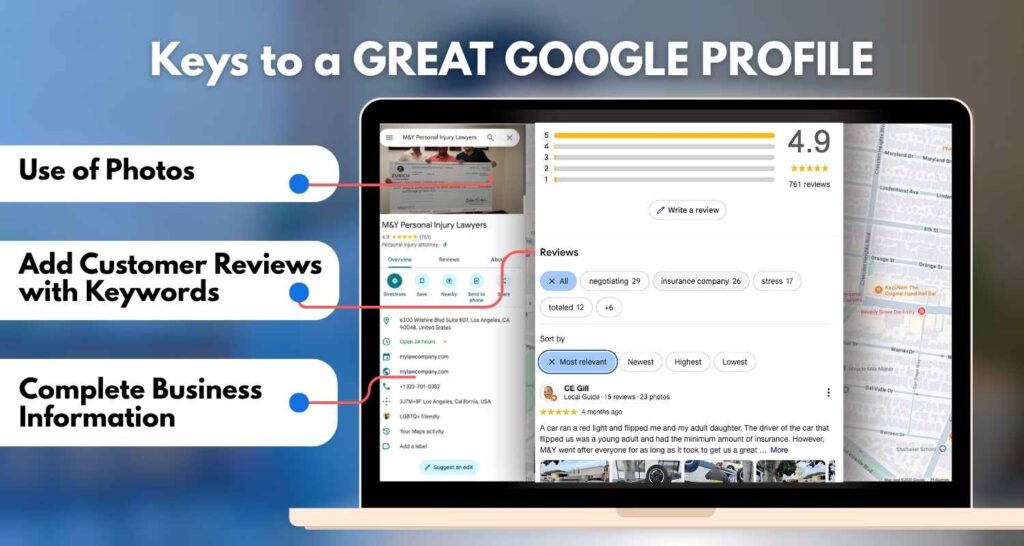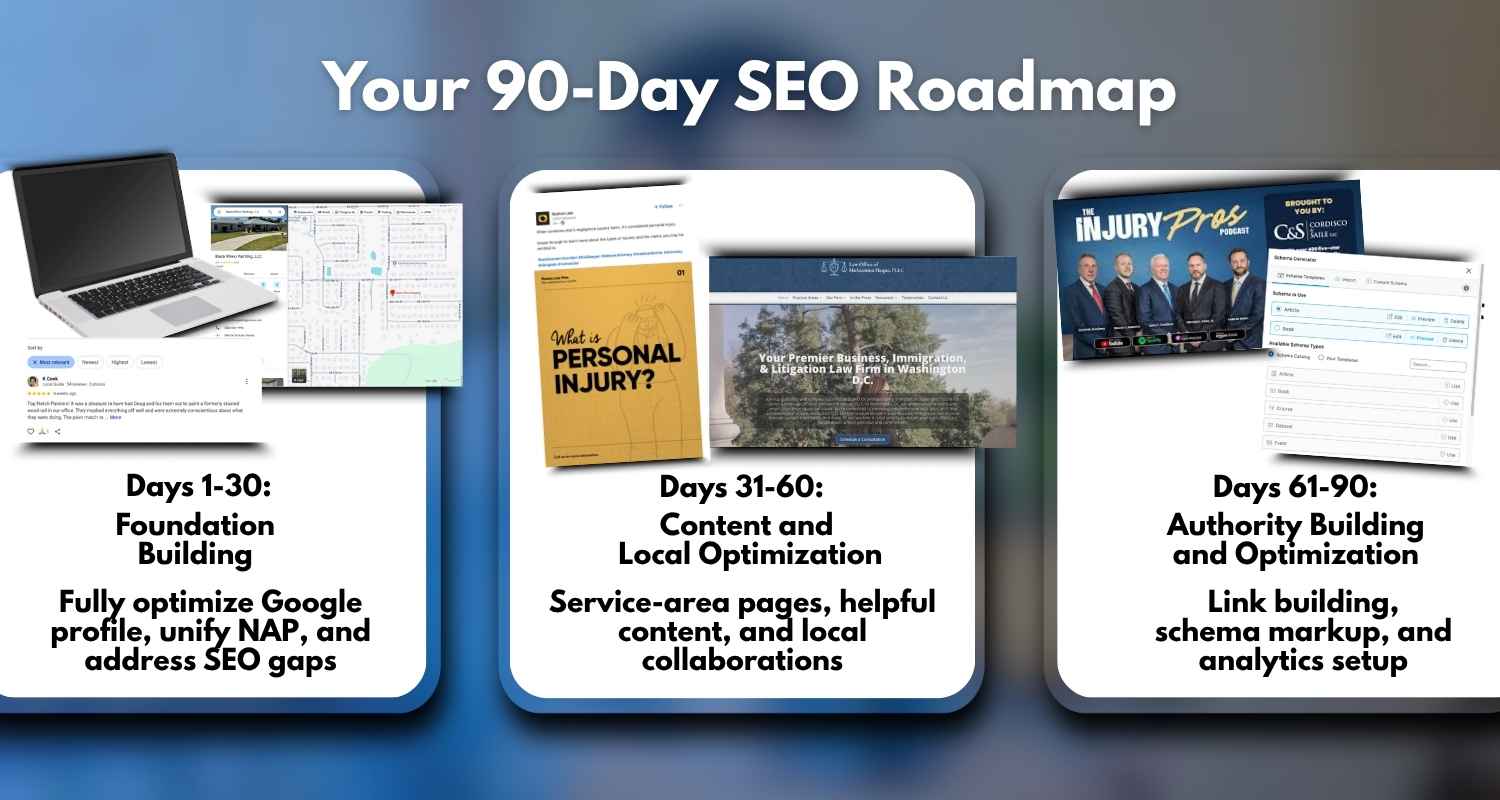Last updated on December 19th, 2025 at 11:39 am
Personal injury lawyer SEO has become the determining factor between law firms that thrive and those that struggle to find clients. Currently, 96% of people searching for legal help begin their journey on Google. That means if your firm doesn’t show up on the first page of search results, you might as well be invisible.
Over 48,000 personal injury law firms operate in the United States, all fighting for the same potential clients. The firms that understand and implement effective SEO strategies are the ones securing the best cases and building sustainable practices.
This guide reveals seven proven personal injury lawyer SEO strategies that separate the market leaders from the struggling firms. These aren’t theoretical concepts; they’re battle-tested methods that have helped countless law firms transform their online presence and dramatically increase their client base.
Contents
Why Personal Injury Lawyer SEO Matters More Than Ever in 2025
The way people find lawyers has changed for good. After an injury, a person’s first move is to search for “personal injury lawyer near me.”
Studies show that 87% of potential clients search for legal services in their immediate area.
The competition for their click is fierce. Most people only contact the first two or three law firms they see. If you’re stuck on page two of Google, you’ve already lost over 90% of potential clients. That’s hundreds of qualified leads hiring your competitors every single month.
This isn’t just about leads; it’s about the million-dollar cases you’re missing. A single significant case can be worth more than your entire annual marketing budget. While paid ads disappear the moment you stop paying, a strong SEO strategy works for you 24/7, attracting new clients for years without any extra cost.
Plus, the way people search is evolving. Voice searches for legal help have skyrocketed by 300% in the last two years. People now ask their phones, “What should I do after a car accident?” The firms that answer these questions are gaining a massive advantage.
1) Want More Local Clients? Start with Your Google Business Profile
Your Google Business Profile (GBP) is your digital front door and often the first impression you make on local searchers. While many businesses set it up and forget it, treating your profile as a dynamic tool is essential for attracting new customers. Here’s how to create and optimize your profile for maximum impact.
Creating and Verifying Your Profile
Follow these initial steps to get your business on the map correctly.
- Log In with a Business Account: Start by logging into Google with the email you want to use to manage your business. Ideally, this should be your company’s primary account (e.g., info@yourbusiness.com), not a personal one, to ensure professional management.
- Create or Claim Your Profile: Visit Google’s Business Profile page and follow the prompts. If a profile for your business already exists, you will need to claim it. If not, you will be guided to create a new one from scratch.
- Choose Your Primary Category Wisely: This is a critical step that tells Google the core of what you do. Be as specific as possible. For example, “Personal Injury Attorney” is much better than “Law Firm,” and “Plumber” is better than “Contractor.” You can add secondary categories later, but your primary one carries the most weight.
- Complete All Core Details: Diligently fill in every section. This includes your official business name, address, phone number, website, hours of operation, and service areas. Don’t skip anything, as a complete profile is a trusted profile.
- Verify Your Business: This step is mandatory. Your profile will not appear live to the public until it is verified. Google will typically send a verification postcard to your business address, but phone or email verification options are sometimes available.

Optimizing Your Profile for Top Performance
Once your profile is verified, the real work begins. An optimized profile will outrank a basic one every time.
Encourage and Manage Reviews: Positive reviews are one of the most powerful ranking factors. Actively encourage satisfied clients to leave feedback. These ratings build immense trust with potential customers and significantly improve your visibility in the coveted local “map pack.”
Perfect Your NAP Consistency: Your firm’s Name, Address, and Phone number (NAP) must be 100% consistent everywhere online. Check your profile against your website, Yelp, Facebook, Apple Maps, and other directories. Even a small difference like “St.” versus “Street” can confuse search engines and damage your local ranking.
Add Specific Secondary Categories: After securing your primary category, add secondary categories for your specific practice areas or services. For a personal injury attorney, this could include “Car Accident Lawyer” or “Medical Malpractice Attorney.” This tells Google exactly when to show your firm to highly qualified searchers.
Bring Your Profile to Life:
Photos & Videos: Upload high-quality, recent photos of your team, your office (inside and out), and professional headshots. Visuals build trust and show you are an active, legitimate business.
Business Description: Write a compelling description that highlights your experience, what makes you different, and the value you provide to clients.
2) Target High-Intent Keywords for Personal Injury Lawyer SEO
To attract the right clients, you need to speak their language. Smart keyword targeting is about understanding what people type into Google when they urgently need help.
Focus on high-intent keywords. These are phrases people use when they’re ready to hire someone now. Think “car accident lawyer near me” or “slip and fall attorney for hire.” These searches often lead to a phone call within hours.
Go for long-tail keywords to avoid getting lost in the crowd. Instead of competing with everyone for a broad term like “personal injury lawyer,” target more specific phrases like “truck accident lawyer in Phoenix” or “attorney for construction site injuries.” These searches are less common but attract highly qualified clients who know exactly what they need.
Use a mix of keyword types:
- Informational: “What to do after a dog bite” (builds trust early on).
- Navigational: “Smith & Jones Law Firm” (helps people find you).
- Transactional: “hire personal injury lawyer” (captures clients ready to sign).
Finally, use keyword research tools like SEMrush or Ahrefs to find hidden opportunities—terms with good search volume but low competition. Sometimes, a keyword with just 50 searches a month can bring in more valuable cases than a highly competitive term you’ll never rank for.
3) Create Content That Answers Real Questions
People who are injured feel stressed, confused, and overwhelmed. Your website’s content should be a resource that offers them clarity and confidence, not a sales pitch.
Create content for every stage of their journey:
- Early Stage (Awareness): Write articles like “Your Rights After a Car Accident” or “Common Types of Personal Injury Claims.” This builds trust by being helpful from the start.
- Middle Stage (Consideration): Create content that explains the process, such as “How Long Does a Personal Injury Case Take?” or “What Evidence Do I Need for My Claim?”
- Late Stage (Decision): Write guides like “Questions to Ask Before Hiring a Lawyer” to help clients feel ready to make a call.
Share your successes. Post anonymized case studies that detail the challenges you overcame to win a favorable settlement. This demonstrates your skill without breaking client confidentiality. (Always add a disclaimer that past results don’t guarantee future outcomes.)
Keep your content engaging by using different formats. Mix articles with videos, infographics, and checklists. A simple post-accident checklist or a settlement calculator can provide immediate value and encourage someone to contact you.
4) Master Technical SEO for Better Rankings
First, your website must be mobile-friendly. Over 60% of all legal searches happen on a phone. If your site is slow or hard to use on a small screen, you’re losing clients. Google now primarily uses the mobile version of a site for ranking, so this isn’t optional.
Page speed is critical. If your site takes longer than three seconds to load, many visitors will leave and go to a competitor. Optimize your images, use good hosting, and clean up your website’s code to ensure it loads lightning-fast.
Use schema markup. Think of this as a special label you add to your website’s code. It tells Google, “This is our address,” “This is a five-star review,” or “This is an FAQ page.” It helps search engines understand your content and can make your listing stand out with eye-catching features in the search results.
Finally, create a clear path through your site with internal links. Connect related pages in a logical way. For example, your main “Car Accidents” page should link out to more specific pages like “Drunk Driving Accidents” and “Rear-End Collisions.” This helps both users and search engines navigate your site.
XML sitemaps and robots.txt files help search engines crawl your site efficiently. Submit your sitemap to Google Search Console and ensure your robots.txt file doesn’t accidentally block important pages from indexing.
5) Build Authority Through Strategic Link Building
In the online world, a link from another respected website is like a digital referral. It’s a vote of confidence that tells search engines your firm is a credible authority.
Quality beats quantity. One link from a major news outlet or a well-known legal organization is worth more than a hundred links from random online directories.
Here’s how to earn valuable links:
- Guest post on reputable blogs. Write a helpful article for a legal, medical, or community blog. Focus on providing real value to their readers, and you’ll earn a link back to your site in return.
- Partner with local organizations. Sponsor a local charity event, team up with healthcare providers who treat accident victims, or work with an auto body shop on a car safety campaign. These relationships often lead to natural links and client referrals.
- Become a source for journalists. Offer your expert opinion on local safety issues or changes in the law. A quote in a news article can earn you a powerful link.
6) Optimize for Voice Search and AI in Personal Injury Lawyer SEO
The way people find information is changing. Voice search and AI are becoming more common, and your firm needs to be ready.
The key is to optimize for conversational questions. People don’t speak to their phones the way they type. Instead of “personal injury lawyer Dallas,” they ask, “Who is the best personal injury lawyer in Dallas?”
Create FAQ sections on your practice area pages. Think of every question a potential client might have and answer it clearly and directly. These direct answers are perfect for both voice assistants and the “featured snippets” that appear at the top of Google’s search results.
By creating helpful, well-structured content that answers real questions, you’re not just optimizing for today’s search engines; you’re positioning your firm as a trusted resource for the AI-powered search tools of tomorrow.
7) Track Performance and Continuously Improve
The best SEO strategies are never finished. To stay ahead of the competition, you must track your performance and continually adapt.
Focus on the metrics that grow your firm:
- Organic Traffic: How many people are finding you through Google search?
- Keyword Rankings: Are you visible for the search terms that bring in the best cases?
- Conversion Rate: This is the most important one. How many website visitors are calling you or filling out a contact form?
Use free tools like Google Analytics and Google Search Console as your dashboard for success. Set up goals to track every new lead, whether it’s a phone call or a form submission. This will show you exactly which pages and keywords are driving your business.
Your competitors are giving you a playbook if you know where to look. Use tools like SEMrush or Ahrefs to see which keywords they rank for and what content is bringing them clients. This will reveal gaps in their strategy that you can exploit.
Finally, give your website a regular check-up. Look for broken links, slow-loading pages, and outdated articles. Find your most popular blog posts and create more content on similar topics. Updating old content with fresh information is a straightforward way to improve its search rankings significantly.
Your 90-Day Action Plan

Implementing these personal injury lawyer SEO strategies requires a systematic approach. This 90-day roadmap breaks down the work into manageable phases.
Days 1-30: Foundation Building
- Complete your Google Business Profile optimization and ensure NAP consistency across all online listings. Conduct comprehensive keyword research for your practice areas and locations. Audit your website’s technical SEO and address any critical issues.
Days 31-60: Content and Local Optimization
- Create location-specific landing pages for each area you serve. Develop a content calendar addressing common client questions and concerns. Begin reaching out to local organizations and publications for partnership opportunities.
Days 61-90: Authority Building and Optimization.
- Launch your link-building campaign through guest posting and local partnerships. Implement schema markup across your website. Set up comprehensive tracking and monitoring systems for ongoing performance analysis.
Quick wins provide immediate improvements while long-term strategies build lasting success. Claiming and optimizing your Google Business Profile can improve local visibility within days. Content creation and link building require months to show full impact, but provide sustainable growth.
Common Mistakes to Avoid
Avoid keyword stuffing, pursuing low-quality backlinks, neglecting mobile optimization, and focusing solely on search engines instead of user experience. Always prioritize providing value to potential clients over gaming search algorithms.
Setting Realistic Expectations
Realistic expectations prevent frustration and maintain long-term focus. Most SEO improvements take 3-6 months to show significant results. Competitive markets may require longer timeframes, but consistent effort always produces positive outcomes.
Conclusion
The difference between law firms that thrive and those that struggle isn’t talent or experience; it’s visibility. While your competitors are still relying on outdated marketing tactics, you now have the roadmap to claim your position as the go-to personal injury lawyer in your area.
These seven strategies aren’t just theory; they’re the same proven methods that have helped countless firms transform from local players into market leaders. But knowing what to do and executing it flawlessly are two different challenges.
We understand the unique challenges of legal marketing and the compliance requirements that govern attorney advertising. Schedule your free strategy session today and discover exactly how to become the Alpha in your local personal injury market.





